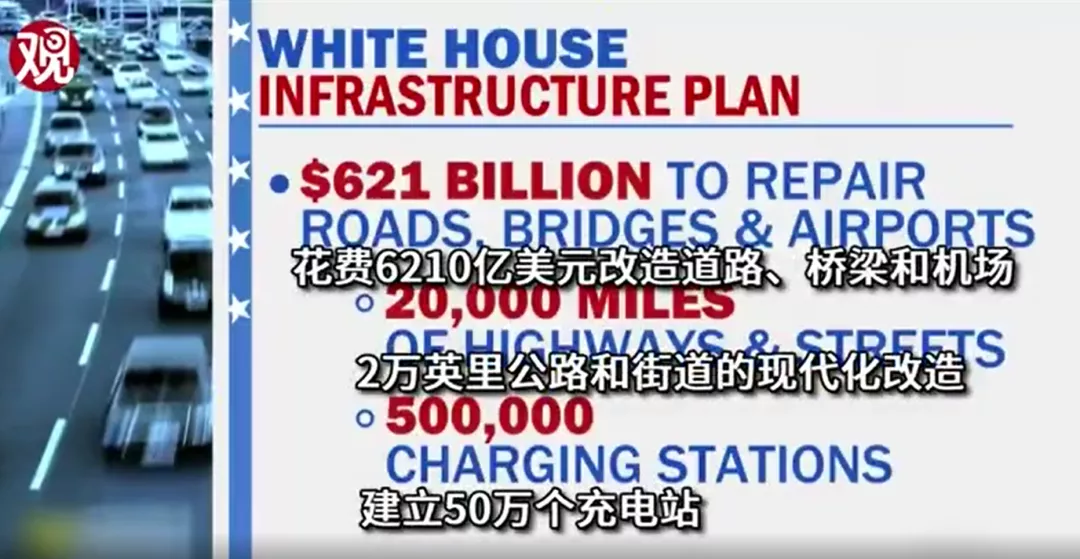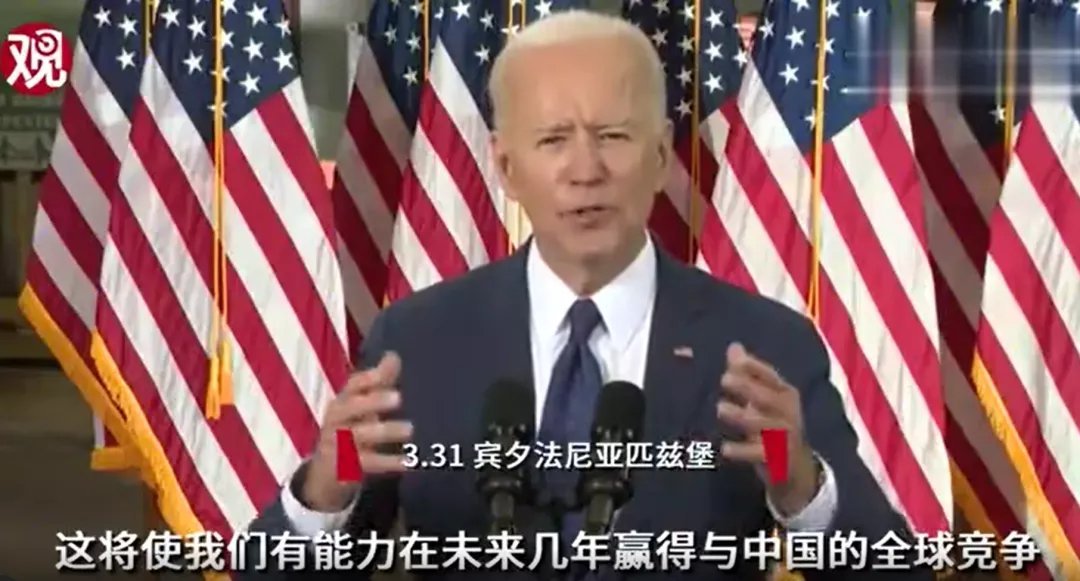“The electric vehicle market in the US is only one-third of that of China, and President Biden believes that this situation must change.”
On March 31, President Biden delivered a speech in Pittsburgh announcing a $2.25 trillion infrastructure and economic recovery plan. That day, the White House also issued a statement titled “The American Jobs Plan,” which outlines the specific allocations of this funding. The announcement stated that Biden proposed that the US government invest $174 billion over the next eight years to regain the electric vehicle market.
This $174 billion will mainly be used to strengthen the electric vehicle supply chain, provide tax incentives for consumers to purchase domestically produced electric vehicles, subsidize local governments to install 500,000 electric vehicle charging stations throughout the US by 2030, and achieve the federal government fleet and 20% of national school buses’ “oil-to-electric” goal.
Biden’s proposal to invest heavily in the electric vehicle industry to enhance its competitiveness overturns the Trump administration’s unsupportive strategy toward electric vehicles and continues to strengthen the electric vehicle policy during the Obama administration.
The White House’s statement mentioned “China” six times, explicitly stating that it aims to exceed China’s investments in infrastructure, research and development, and construction, and electric vehicles are also a key focus.
This plan, which exceeds $2 trillion, will require the approval of Congress, and its implementation will not take place until 2022. Biden stated that if he cannot obtain sufficient support from Republican Senators, he will consider initiating the “budget reconciliation process” again to bypass the Republicans and directly promote the legislative process of the plan.
Charging Stations: From 100,000 to 500,000
According to related statistics, there are currently about 100,000 electric vehicle charging stations in the US, of which 32,000 are in California.
Insufficient charging infrastructure has hindered the development of the US electric vehicle market. A report by research firm IHS Markit showed that in 2020, electric vehicles accounted for only 1.8% of newly registered light vehicles in the US.
Jonathan Levy, the Chief Business Officer of electric vehicle charging company EVgo, previously served in the US Department of Energy during the Obama administration. He revealed that currently, approximately 30% of Americans do not have the conditions to charge their electric vehicles at home or at work, even if they buy an electric vehicle.
The White House stated in the announcement that a portion of Biden’s $174 billion will be used to provide financial incentives for local governments and related private organizations to achieve a network of 500,000 electric vehicle charging stations throughout the US by 2030.
Consulting firm AlixPartners predicts that by 2030, there will be 18 million electric vehicles on the road in the United States.
Mark Wakefield, AlixPartners’ chief market analyst, said the US charging station industry definitely needs financial support from the government, as automakers do not have the money to build charging infrastructure, and while some institutions have some money, the cost of charging stations is too high to make the business feasible.
In addition to direct subsidies, Biden’s Green Act proposed in February of this year states that the US Department of Energy will develop a plan to provide technical support for areas where charging infrastructure is insufficient and for construction projects that meet the criteria.
Significant increase in subsidy ceiling
The White House statement said that the American Jobs Plan will provide tax credits and incentives for consumers buying American-made electric vehicles, ensuring that all families can afford them, without specifying the specific amount and distribution criteria of the incentives.
However, in the Green Act, the Biden administration stated that the maximum tax credit for each electric car purchased during the Obama administration, which was $7,500, will be lowered to $7,000.
Although the tax credit amount has been reduced, unlike previous subsidy policies, users who purchase used electric cars and have owned the vehicle for more than two years and paid less than $25,000 can also receive a $2,500 tax credit.
The biggest change in Biden’s new policy from the old one is that during the Obama administration, the federal government set a tax credit limit of 200,000 electric vehicles per automaker. Once the number of electric vehicles sold by an automaker reaches 200,000, tax credits will no longer be eligible. Both Tesla and General Motors have exceeded this limit.
However, the Green Act proposes to raise the tax credit limit from 200,000 to 600,000 electric vehicles. That is to say, if Biden’s proposal is passed, Tesla and GM will be given an additional sales quota of 400,000 vehicles and can continue to receive subsidies from the new US government. However, it is uncertain whether this new regulation has retrospective effect since the sales volume of these two automakers has already exceeded 200,000.
In fact, as early as the end of 2020, when Biden announced his victory but had not yet officially taken office, he proposed a significant increase in the tax credit limit. However, then-President Trump vetoed the proposal and demanded a complete cancellation of tax credits for electric vehicles, stating that this would save the government $2.5 billion in expenditures over 10 years.
Build, Build, Build, Buy, Buy, Buy
Made in the USA is the core of the Biden administration’s $2 trillion plan, and electric vehicles are no exception.The White House statement said that Biden’s plan will stimulate the domestic supply chain of the US electric vehicle manufacturers, including raw materials and other components, and improve global competitiveness through restructuring factories. In addition, the funds will also help American workers produce power batteries and electric vehicles.
Biden administration has proposed strengthening the US electric vehicle manufacturing competitiveness more than a month ago.
On February 26th, Biden officially ordered a 100-day review of potential weak links in the US supply chain, including computer chips, medical devices, electric vehicle batteries, and rare earth minerals.
At that time, the White House issued a statement saying that although the US is a net exporter of electric vehicles, it is not a leader in the battery supply chain. Therefore, the US hopes to use its considerable lithium reserves and manufacturing technology to expand domestic battery production.
The White House also stressed that the US’s inadequate investment in domestically produced chips has undermined national innovation capabilities, “We are making mistakes ourselves, and other countries are inspired by our mistakes.”
After ensuring American manufacturing, it is time to buy, buy, buy.
In addition to providing tax incentives for private purchases of American-made electric vehicles, Biden’s $174 billion funds will also be used for the “Oil-to-Electricity” program for federal government vehicles and some American school buses.
The White House statement said that under Biden’s plan, 50,000 diesel transport vehicles will be replaced with electric vehicles in the US, and at least 20% of school buses will be replaced with electric vehicles through the Clean Buses for Kids Program of the Environmental Protection Agency. At the same time, the federal government will also purchase a large number of electric vehicles to complete the government fleet’s electric vehicle replacement plan.
As early as January 25th, a few days after Biden was inaugurated as the new US president, he signed an executive order of “Buy American” and plans to replace federal government vehicles, including the United States Postal Service (USPS), with American-made electric vehicles, totaling about 650,000 vehicles.
However, he did not give a replacement time at that time, and the White House did not respond to how much it would cost to “oil-to-electricity” the fleet of this scale. Some analysts pointed out that replacing all government fleet vehicles with electric vehicles may cost $20 billion or even more.
Biden’s $2 trillion plan is for eight years, and the deadline for building 500,000 charging stations is set for 2030. Perhaps the federal government’s vehicle replacement time is also around this time.## In his speech in Pittsburgh, Biden called the $2 trillion plan the largest employment investment in the United States since World War II, capable of creating millions of job opportunities. However, there is a question as to whether he can serve two full presidential terms and ensure the implementation of this eight-year infrastructure plan.
This article is a translation by ChatGPT of a Chinese report from 42HOW. If you have any questions about it, please email bd@42how.com.
